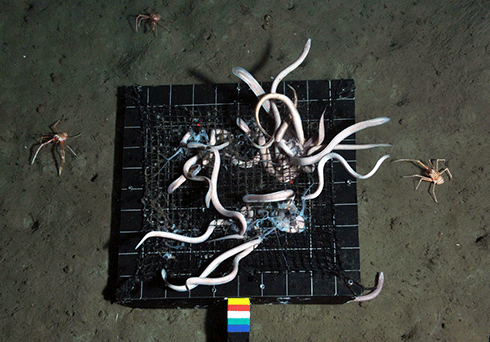
|
Published: 27 October 2014
Deep-sea creatures tuck into jellyfish ‘manna’ from above
Jellyfish blooms may be important food supplements to deep-sea food webs, according to recent research.

|
|
Hagfish and crustacean amphipods scavenge jellyfish baits in the deep sea. Credit:
A Sweetman, C Smith and D Jones
|
Globally there are huge numbers of jellyfish in the oceans. In some parts of the ocean, jellyfish ‘blooms’ are increasing, possibly due to nutrient enrichment and climate change caused by human activities.
Researchers from Hawai'i, Norway, and the UK have shown that a rise in jellyfish blooms near the ocean's surface leads to jellyfish ‘falls’ that may be rapidly consumed by voracious deep-sea scavengers such as hagfish and crabs.
‘We just had a hunch that dead jellyfish were important to deep-sea ecosystems in some way, even though they are made up largely of water,’ says lead author, Andrew Sweetman from Norway’s International Research Institute of Stavanger.
‘We therefore decided to film what the fate of jellyfish carcasses was at the seafloor, so we deployed deep-sea lander systems with jellyfish bait.
‘When we looked at the camera images and saw just how fast the jellyfish baits were consumed and the sheer number of scavengers that were consuming the baits, it just blew our minds!’
Craig Smith, co-author and Professor of Oceanography and Pew Fellow in Marine Conservation at the University of Hawai'i added: ‘The speed of the jellyfish scavenging was totally unexpected because previous observations seemed to suggest that jellyfish carcasses would just rot very slowly at the seafloor.
‘It was also really interesting that hagfish targeted the most energy-rich parts of the jellyfish, burrowing into the jellyfish carcasses to eat the gonads.’
The findings indicate that the role of jellyfish material may be significantly underestimated in global oceanic carbon budgets; if jellyfish are removed quickly, they will not accumulate on the seafloor, causing scientists to overlook their role in deep-sea food webs.
Another co-author, Daniel Jones, from the UK’s National Oceanography Center said: ‘Until we saw these photos we thought that the massive amount of jellyfish material was deposited on the seafloor and was essentially taken out of the system – removing carbon rapidly.
‘Our results show that much of this carbon could, in fact, make it into deep-sea food webs, fuelling these systems. This is especially important when other food sources to deep-sea ecosystems may be decreasing as our oceans warm.’
Source: University of Hawai’i



